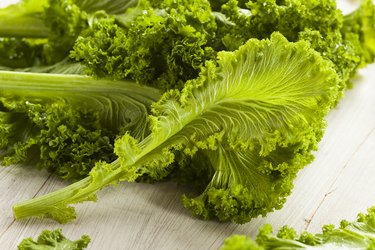
It's well known that leafy greens, which include collards, kale and chard, are all extremely nutritious. However, each variety has its own distinct taste and appearance as well as appropriate preparation techniques. Learning the differences between collards and other similar-looking greens, which are often placed right next to each other on supermarket shelves, helps home cooks choose the best options for a dish. Experimenting with different greens in the kitchen can also help you discover new favorites.
Collards and Similar Leafy Greens
Video of the Day
Collard greens, which are typically sold as bunches of individual whole leaves, are easy to distinguish from smaller, more delicate loose leaves, such as spinach, arugula and dandelion greens. They are also distinct from cabbages and lettuces that are sold whole with their leaves held tightly together by a single root rather than as loose leaves. The differences are more subtle between collards and similar-looking greens that are also sold as bunches of whole leaves. These include kale and chard, which come in different varieties, as well as beet greens and turnip greens.
Video of the Day
Collard greens are usually the largest of this group of similar-looking greens in terms of leaf size. They are larger than the span of a hand and roughly oval in shape. They are a dark, glossy green with pale green stems and veins and with a sturdy, almost leathery texture.
Although they can be eaten raw, collard greens are typically cooked, which reduces their moderate bitterness, and they are substantial enough to benefit from long, slow cooking techniques. The classic southern preparation is a long braise with ham hocks. Collards' characteristics also lend the leaves to stuffing and as alternatives to wraps and buns for burgers and sandwiches.
Collard Greens vs. Kale

Kale leaves tend to be a bit smaller and narrower than collards and are similarly sturdy although not quite as thick. Common types of kale include red, or Russian kale, with red-hued stems; curly kale with frilly edges; and Tuscan, or dinosaur kale, which has a rumpled texture and deep green color. Like collards, kale has tough stems that should be cut away. The moderately bitter flavor and fibrous texture of kale are similar to collards, and the two can be used interchangeably in some dishes.
Kale tends to be used raw more often than collards, such as in salads and smoothies, and it also crisps up nicely when roasted, unlike collards. Kale is also a popular choice in cooked dishes, including slow-cooked dishes, where it is a suitable substitute for collards. However, kale leaves are not usually large enough to replace collards as a wrap or in stuffed collard recipes.
Collard Greens vs. Chard
Chard has similarities with both collards and kale in that it has large, slightly rumpled dark green leaves. Swiss chard has white stalks, whereas rainbow chard includes varieties with yellow, red or orange stems. Unlike collard and kale stems, chard stems become soft and palatable with cooking and are often cooked along with the leaves.
Chard is milder in flavor, less bitter and less fibrous than collards and kale. It can be eaten raw or blanched but is more popular in cooked applications, usually with quick-cooking techniques, such as stir-frying, sauteeing and adding to soups or stews to wilt just before serving.
Beet Greens and Turnip Greens vs. Collard Greens
Turnip greens and beet greens are usually sold still attached to their edible bulbs, which makes them very easy to identify. Otherwise, the greens are harder to distinguish from similar leaves, such as collards, kale and chard. Beet greens look most similar to chard, with veins in the same purplish or orange hue as their beets. What's the difference between collards and turnip greens? Turnip greens are more similar to beet greens than collards but with thinner whitish stems.
Beet greens taste most similar to chard, also being less bitter and milder than collards and kale. Turnip greens have a distinctly peppery flavor. Like chard and unlike collards and kale, the stems of turnip and beet greens are edible and are often cooked with the leaves. Beet greens and turnip greens can be eaten raw as well. Turnip greens and collard greens both feature in traditional Southern cuisine in similar slow-cooked dishes.
Mustard Greens vs. Collard Greens

When considering mustard greens vs. collard greens, the two leafy greens are visually quite distinct. Unlike collard's large, thick, flat, dark green leaves, mustard greens are usually a paler, brighter shade of green. They are thinner and narrower, with frilly edges and slender stalks. Some varieties of mustard greens have a purplish hue. Tastewise, mustard greens have a peppery, spicy flavor akin to prepared mustard with some bitterness. They are eaten raw or cooked with similar applications to collards, and they have a similar place as collards and turnip greens in Southern cuisine.